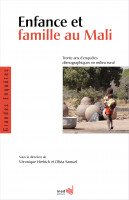
1939-1945. Une démographie dans la tourmente
Outside-of-series works
2015, 384 pagesPréface, Henry Rousso
Chapitre 1. Guerre et population, Paul Vincent
Première partie : Pertes de guerre, la démesure des chiffres
Chapitre 2. Pertes de guerre, collectif
Chapitre 3. Les guerres, les morts et le deuil : bilan chiffré de la Seconde Guerre mondiale, Pieter Lagrou
Chapitre 4. Pertes de guerre en URSS : un nouvel éclairage, Alain Blum et Sergej Maksudov
Chapitre 5. La Pologne nouvelle, Sully Ledermann
Chapitre 6. La République populaire de Roumanie, Sully Ledermann
Deuxième partie : Naître, sʼunir, se désunir en guerre
Chapitre 7. La guerre biologique (1933-1945), Alfred Sauvy et Sully Ledermann
Chapitre 8. Conséquences de six années de guerre sur la population française, Paul Vincent
Chapitre 9. La situation démographique, Jean Bourgeois
Chapitre 10. Guerre et nuptialité, François Ronsin
Chapitre 11. Les divorces en France et la Seconde Guerre mondiale, Patrick Festy
Chapitre 12. La reprise de la natalité dans le monde. Ses causes, ses chances de durée, Alfred Sauvy
Troisième partie : L’enfance dans la guerre
Chapitre 13. La vulnérabilité des enfants : les crises de mortalité de 1940 et 1945, Catherine Rollet et Virginie De Luca
Chapitre 14. Répercussions des calamités de guerre sur la première enfance, Hélène Bergues
Chapitre 15. Le problème du lait en France, Albert Michot
Quatrième partie : Déportations, exterminations, personnes déplacées
Chapitre 16. Bilan d’une œuvre de destruction, Jean-Pierre Azéma
Chapitre 17. Mouvements migratoires d’après-guerre, Jacques Doublet
Chapitre 18. Naissance d’une nation : les personnes déplacées de l’après-guerre, 1945-1951, Daniel G. Cohen
The Second World War, with its massive and exceptional loss of life – 40 million deaths on the European continent alone – was an immense human tragedy, in which civilian deaths greatly outnumbered those on the battlefield. It was a time of chaos that affected all populations, be they soldiers, prisoners of war, political detainees, refugees, or victims of bombardment, mass murder, extermination or famine.
The demographic destiny of hundreds of millions of men, women and children was irrevocably altered. Forced separations, the dispersal and decimation of families, and countless untimely deaths all made their mark on long-term patterns of mortality, fertility, childbearing and marriage over the following decades.
Translating these cataclysmic events into figures is no easy task. In the immediate aftermath of the war, demographers attempted to count its human cost and assess its effect on the population pyramid. These estimates have been refined over the years, as new archives become available to researchers.
Some 70 years after the end of the Second World War, this collection of historical and demographic texts, articles, and book excerpts provides a general overview, at the European level, of a unique turning point in the history of population.







